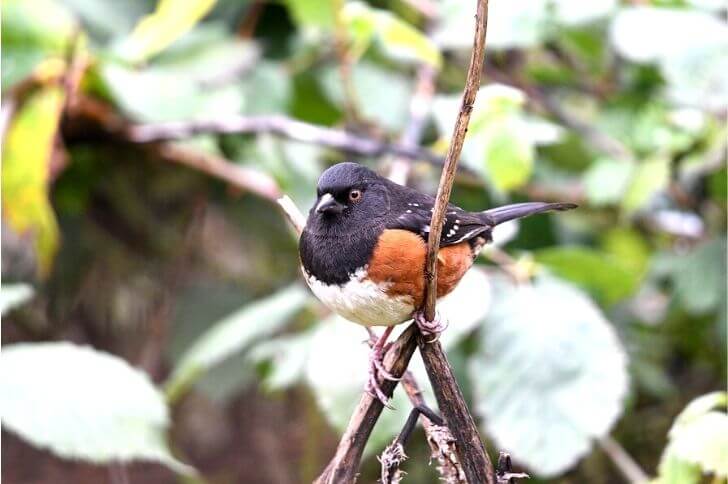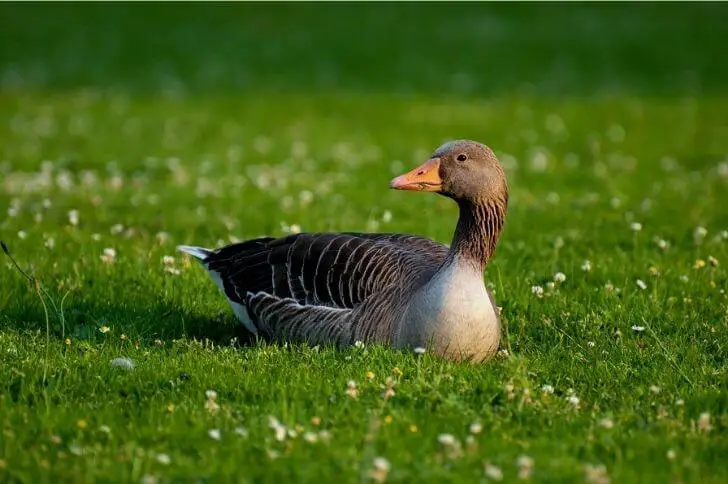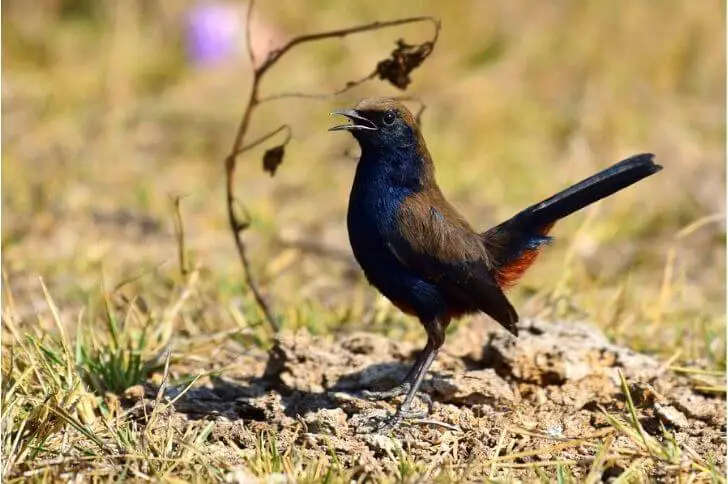There are many different types of birds that start with T. From turkeys of North America to brightly colored toco toucans of South America, there are plenty of birds that begin with letter T.
In the article below we’ll look at small and big interesting birds that can be found in different parts of the word. These t birds, as we call them, are not only intriguing but you’ll learn about their habitats, eating habits, and more.
Birds that start with T
1. Tanager finch
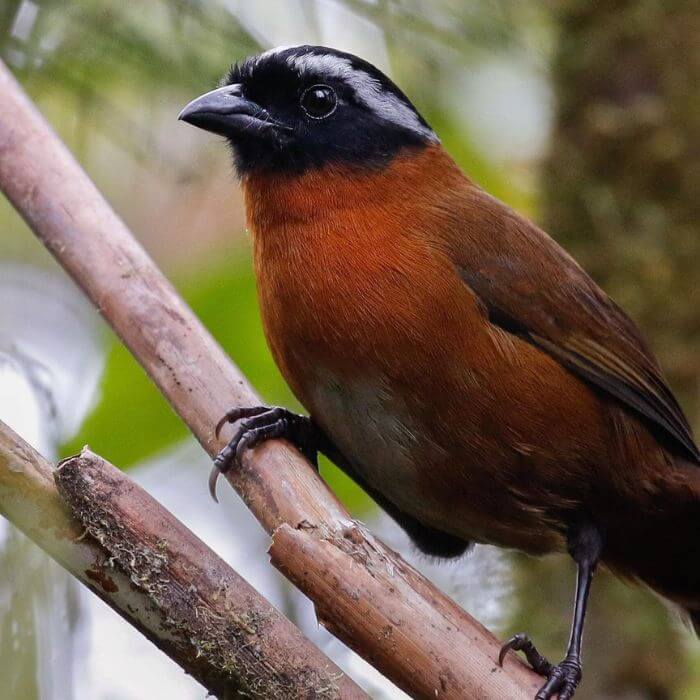
Tanager finch – Oreothraupis arremonops
source:montezumarainforest
The tanager finch is a small, sparrow-like bird found in parts of South America. These birds are typically chestnut brown, have a black-colored head with silver-grayish stripes on the sides.
Tanager finches have short, conical beaks and typically feed on insects and seeds. They are also vocal birds, producing a series of high-pitched songs from the tops of trees
Tanager finches build their nests out of grass, twigs, and other plant material. These birds are monogamous, and both parents work together to care for their young.
2. Tytler’s leaf warbler
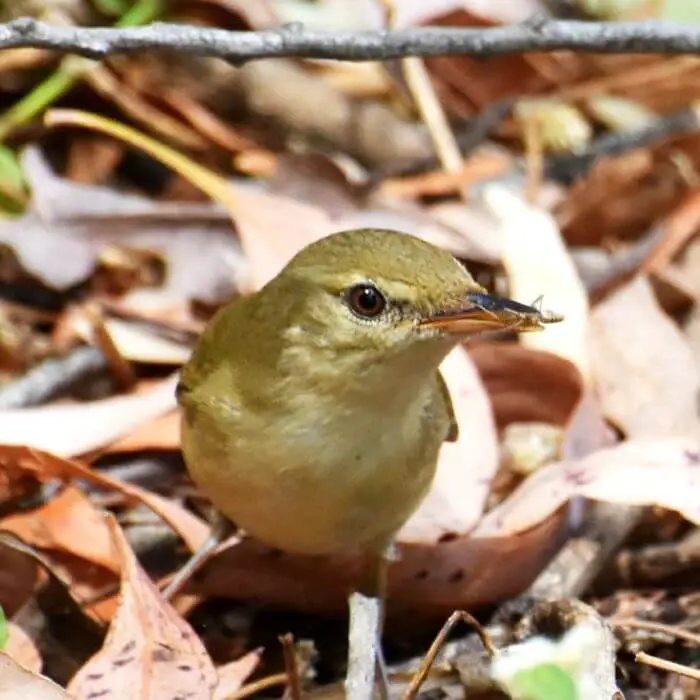
Tytler’s leaf warbler – Phylloscopus tytleri
source: rulidassen
Another small bird that starts with T is the Tytler’s leaf warbler. Widely found in the Himalayas this passerine is a member of the leaf warbler family, Phylloscopidae.
Both sexes are sexally monomorphic. Both have gray upperparts with hints of green on the wings and pale underparts. Notice the cute whitish brow. This species is named after Dr Tytler, who collected the first specimen in 1847.
3. Tristan thrush
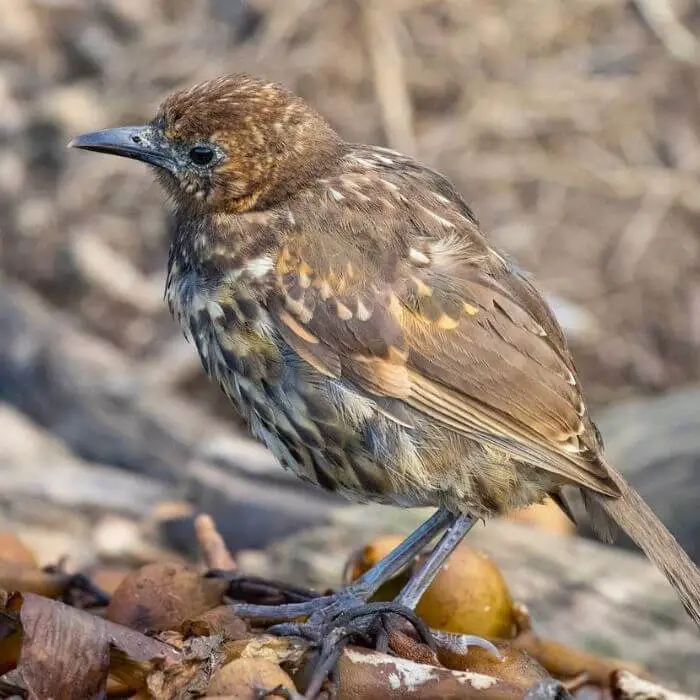
Tristan thrush – Turdus eremita
source: naturebybergstrom
The large thrush family consists of over 174 species and the Tristan thrushes belong to this family.
They are small brown birds and are closely related to the American robin. These thrushes can be seen walking around and their dark plumage enables them to blend into their surroundings. The Tristan thrush eats insects, spiders, and other small invertebrates. It also eats berries and fruit from trees and shrubs.
They build a cup-shaped nest of grasses, twigs, and other materials in a tree or bush. Females lay two to four eggs, which are incubated by both parents for about two weeks. After hatching, the chicks are cared for by the parents for about four weeks until they are able to fly and care for themselves.
4. Tibetan rosefinch

Tibetan rosefinch – Carpodacus roborowskii
source: bendielissen
Tibetan rosefinches are endemic to the Himalayas. They have a distinctive pink-raspberry color that is common in the Fringillidae family.
They are sexually dimophic. You can easily tell the sexes apart; males are pink while the females are grey-brown and pale underneath.
Though these rosefinches are almost always quiet, they, at times, whistle and produce hissing sounds. Next time you go vacationing, make sure to get a good photo of these sociable birds.
Related: Learn about other birds that start with k
5. Tawny-chested flycatcher

Tawny-chested flycatcher – Aphanotriccus capitalis
source: c_u_l_pics
Tawny-chested flycatchers are another group of birds beginning with t. The tawny-chested small stocky birds with yellow bellies. Their heads, back and tails are all gray. Males and females share similar traits.
They are related to the Old World flycatchers, feeding mostly on insects caught in midair. The tawny-chested flycatcher builds a small cup nest of sticks high in a tree, and lays two or three eggs.
6. Tabar pitta

Tabar pitta – Erythropitta splendida
source: creagrus
Tabar pittas are common birds in the forests of New Guinea. Being a member of the pitta family, there are a few things you can expect and that will help you identify them.
One, like others pittas, the Tabar pittas are brightly colored. You’ll notice its vibrant red belly that is separated to the light blue chest by a black stripe. Their head is orange with blue-green upper parts. This bird feeds on insects, small lizards, and fruit.
7. Twite bird

Twite bird – Linaria flavirostris
source: chris.armstrong.photography
Twite birds are small 5 – 6-inch birds that are generally found in northern Europe. They have a wingspan of about 9-10 inches. Twite birds have soft streaked backs with pale underparts.
These passerine birds lay up to 6 eggs each breeding season and are migratory birds, moving to warmer regions in winter. You’ll find them on the ground where they look for seeds.
8. Tree martin

Tree martin – Petrochelidon nigricans
source: nrobyn
Tree martins are a type of passerine bird that is found in Australia. They are often mistaken for swallows, as they share many of the same characteristics.
Tree martins average 5 inches with a dark bark and head, and whitish underneath. These birds make their homes in tree cavities. They are insectivores, meaning that they eat insects for sustenance. Tree martins typically migrate south for the winter, but some may stay in their breeding territory if it is mild enough.
9. Thicket antpitta

Thicket antpitta – Hylopezus dives
source: arcticory
Plump, short tail, and a streaked body, the thicket antpitta is a medium sized bird that is found in rainforests of South America. They have a brownish coloration with a streaked chest.
These birds are quite shy and secretive, hiding in the dense forests. They build their nests close to the ground and lay between 2 and 4 eggs.
Related: Bird name list
10. Tawny owl

Tawny owl – Strix aluco
Tawny owls are medium-sized, brown owls found in most parts of Asia and Europe.They are highly-territorial raptors that are in the British Isles
. Tawny owls are mainly nocturnal, but can sometimes be seen during the day. They feed on small mammals, and birds
When it comes to nesting, Tawny owls prefer using tree holes instead of building nests made of grass. Breeding starts from late winter to early summer, laying 2-4 eggs that hatch after 30 eggs. The chicks fledge about 9 weeks after hatching.
11. Tahiti petrel
Another Tahitian bird that starts with K is the Tahiti petrel. This seabird is found in the South Pacific.
Tahiti petrels are medium-sized birds that boast of a 33-inch wingspan. The powerful wings allow them to glide over the water as they hunt for food.
To easily identify this bird, look out for dark-brown upper parts and white underneath. It has a thick bill with easy-to-spot nasal tubes.
12. Turquoise parrot
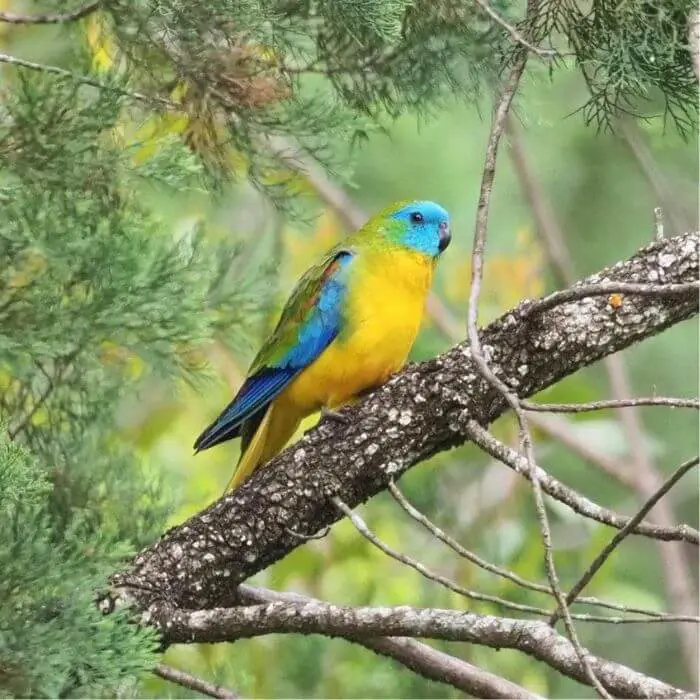
Turquoise parrot – Neophema pulchella
source: inverellnsw
Turquoise parrots are small parakeets that are endemic to part of Australia. These parakeets are sexually dimorphic. Males are quite eye-catching. They feature distinctive green upperparts, a turquoise blue face and crown. There are also blue patches on its wing. Notice the red patch on its wing? That is another feature that will help you to identify a male turquoise parakeet.
The female and young birds have a duller plumage and don’t have the red patch on their wings.
Turquoise parrots are a social species that lives in flocks of up to 100 birds. They are known for their loud, high-pitched calls which can be heard from long distances. Turquoise parrots eat fruits, nuts, and seeds.
14. Torresian crow

Torresian crow – Corvus orru
Another bird that is common in parts of Australia is the Torresian crow. It is one of the largest members of the crow family, measuring 21 inches long.
Torresian crows are scavengers and carrion eaters, and have been known to steal food from other animals. They are also a notorious nest robber, often raiding other birds’ nests for eggs and chicks.
The Torresian crow is a common sight in cities and towns, where it often scavenges for food in rubbish bins and streetside garbage piles.
15. Thick-billed kingbird

Thick-billed kingbird – Tyrannus crassirostris
source: calikatbird
If you live in Arizona, chances are this bird will visit your backyard. Thick-billed kingbirds are medium-sized birds that have a gray – brown upper body with a darker head.
Underparts are white with a pale yellow belly. Thick-billed kingbird is part of the tyrant flycatcher’s family. When breeding, they can be really aggressive, protecting their 3 – 4 whitish eggs. Thick-billed kingbirds eat insects and are sometimes seen catching them in midair.
16. Tarim babbler

Tarim babbler – Rhopophilus albosuperciliaris
source: maxberlijn
The Tarim babbler is a passerine bird with a long tail and buff-colored plumage. The Tarim babbler is unique among passerines in that it is partially migratory; during winter, much of the population moves to lower elevations, while some birds remain in the highlands year-round. This babbler looks for food close or on the ground.
Tarim babblers were first described by a British ornithologist in the 1800s. The scientific name commemorates the ancient city of Tarim, located in what is now Xinjiang Province.
17. Tablas fantail
There are many birds that start with the letter T and one of the most fascinating is the tablas fantail.
Tablas fantails are known for their bright colors and unique tail feathers. They have a unique dark-blue color on their head, shoulder, chest and back. They feature a buff belly, wings and tails.
The most distinctive feature of this bird is its long, fan-shaped tail feathers. Tablas fantails use their brightly colored tails to attract mates and scare away predators. They are also very vocal birds, making loud chirping noises to communicate with others.
18. Tufted duck

Tufted duck – Aythya fuligula
Tufted ducks are waterbirds that can be found in parts of Europe and Asia. Common in marshy regions and open reservoirs, these birds are easy to identify.
When you whip-out your bird watching binoculars you’ll notice their boldly patterned body for males, these colors are used to make the male’s appearance more conspicuous during courtship, and dark brown females. Both sexes have crests with females having a shorter crest “tuft”.
Tufted ducks feed on aquatic plants, insects and small fish. Notice its stunning yellow eyes? Intriguing.
19. Tiny hawk

Tiny hawk – Microspizias superciliosus
source: canopyfamily
Tiny hawks are small raptors that are found in parts of the Americas. These birds are appropriately named. They measure about 8 inches males and 10.5 inches females.
In comparison, the largest hawk in the US, the ferruginous hawk, measures about 25 inches in length with powerful wings that measure up to 56 inches.
Tiny hawks eat different types of birds and small animals, preferably hummingbirds.The tiny hawk has a brownish-gray body with a light gray face and darker crown, and it has a short tail and broad wings.
20. Tepui swift
Tepui swifts are endemic to Brazil. They are related to the common swift and are often mistaken for them.
The Tepui swift can be distinguished from the common swift by its smaller size and darker coloring. Also, it has a chestnut collar. It is an aerial bird, spending most of its time soaring high in the sky. It feeds on insects, which it catches in flight.
21. Talaud bush-hen
The Talaud bush-hen is a small rail found on the Talaud Islands. It is a bird of heavily vegetative or swampy habitats and is usually seen walking on the ground. It is buffy brown above and paler below. The bill is black while legs are yellow.
Talaud bush-hens are protected birds.
22. Turkeys

Our list of birds that start with would be incomplete if we didn’t mention one of the most common birds in North America. Turkeys are a bird that comes in different shades.
Wild turkeys are more colorful with feathers ranging from bronze-green to darker colors. Domestic or backyard raised turkeys come in white and a variety of other colors.
These birds have a large, bald head and a red wattle or fleshy protuberance on their neck. Turkeys weigh around 12 pounds and can reach up to 4 feet in length. They live for 10-12 years. Male turkeys, or gobblers, have a unique call that is used to attract mates.
Female turkeys, or hens, lay anywhere from 8-15 eggs at a time which they will incubate for 28 days. Turkeys are omnivorous and eat seeds, insects, small animals, and fruit.
23. Toco Toucans

Toco Toucans – Ramphastos toco
If you love watching interesting birds while on your bird watching trip, the toco toucan definitely arouses interest. Toco toucans are brightly colored birds found in the rainforest of Central and South America.
They are easily recognized by their large, colorful beaks. Toucans are fruit eaters and use their long beaks to reach fruit high in the trees. They also eat insects and other small animals. Toucans are social birds and live in groups of up to 20 birds. They make a variety of sounds, including a loud trumpeting call.
Toco toucans build nests in tree cavities or on vines. The female lays 2-4 eggs, which the male incubates for 16-20 days. The chicks stay with the parents for several months after hatching.
24. Tufted titmouse
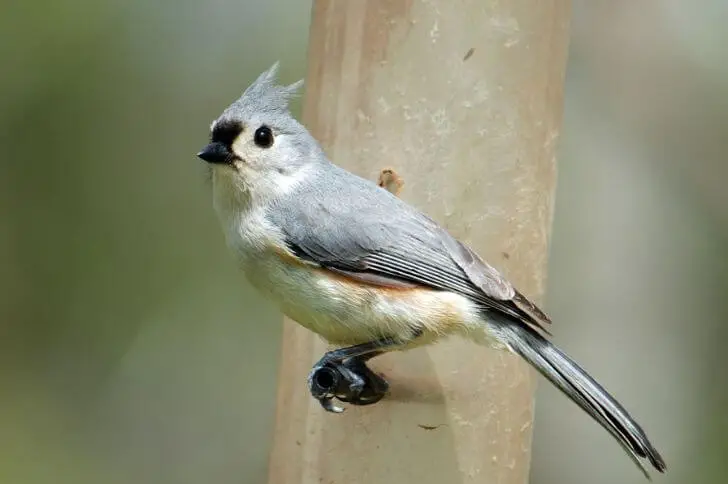
Tufted titmouse – Baeolophus bicolor
The Tufted titmouse is a small passerine bird found in North America. It is the only member of the genus Parus. This species was formerly considered conspecific with the Blue tit, but has been shown to be a separate species based on genetic evidence.
Tufted titmouse inhabits a wide range of habitats, from arid deserts to dense forests, and can be found in both rural areas and major cities. This bird is relatively common and not considered threatened by conservationists.
25. Tacazze sunbird
With a long bill and dark legs, tacazze sunbirds are beautiful birds that are quite a sight. This bird spots a copper-green color on its head, gorgeous purple on its shoulders and black on its back and underparts.
This bird is named after the tacazze tree, which is where it was first observed. It has a long tail and short legs. The Tacazze sunbird feeds on insects, spiders, and other small invertebrates.
26. Tyrant flycatcher

Tyrant flycatcher – Tyrannidae
Looking for a bird that is both striking and easy to identify? Look no further than the Tyrant flycatcher. Tyrant flycatchers are common birds that can be found in most habitats across North America.
It is easy to identify due to its small size, grayish-olive color and stubby bill. Both sexes measure about the same size, 5 inches, same color grayish olive but females do not have crowns.
Tyrant flycatchers prefer thickets and woodlands.
27. Tambourine dove
Tambourine doves are small-headed birds endemic to some African countries. These birds weigh about 3 oz are mostly dark brown back and white underparts for male while females are duller with a brown back.
The tambourine dove feeds on seeds, berries, and insects. It nests in cliffs or in holes in rocks.
28. Taczanowski’s Tinamou
Taczanowski’s tinamou is a loud bird that is common in Southern parts of Peru. What’s most interesting about this bird is the female lays 1 – 2 eggs which the male incubates and also takes care of the hatched chicks.
Today, the Taczanowski’s tinamou is one of the most endangered birds in the world. The primary threats to this bird are habitat loss and degradation, hunting, and competition from introduced species.
29. Trogon
Trogons are a large and strikingly beautiful bird, with long tails, broad wings, and powerful beaks.
Majority of these birds are found in the Americas forests. They are members of the trogonidae family. Trogons are intelligent birds, with good vision and hearing. They are able to fly very fast, eat mostly insects, but they will also eat small animals or fruit.
30. Turaco bird
One of the things that strikes most birders about the turacos is their interesting crest. Also known as lorries, turacos have some of the most magnificent crests in the bird world.
These large, brightly coloured birds are not the tallest or heaviest bird in their family, but are some of the most distinctive.
The male has a spectacular crest of feathers on its head, which can be raised and lowered to display dominance over other males during breeding season. The turaco is also notable for its unusual voice, which sounds like a cross between a laugh and a cackle.
31. Towhee
Have some overgrown borders or shrubs in your backyard? Towhees love this and you might see them in your home.
Towhee bird is another bird beginning with t. This small, sprightly bird is very active and playful, often darting around and picking up small objects. They are social birds, often seen in flocks of up to 20 individuals. They are songbirds that typically sing short, sweet notes.
32. Tragopan
Another colorful bird that should be on every birder’s must-see bird list is the tragopan. They are unique and beautiful birds found throughout Southeast Asia.
This medium-size horned bird measures about 28 inches long and weighs up to 4.9 lb. They are shy animals that live in tropical rain forests and eat fruit, flowers, and insects.
33. Turnstone bird
Turstone birds are the same size as spotted towhees. They are small blackish- brown and white birds that can be found on both coasts of the United States.
This bird is known for its ability to ride the waves, as it can swim well and easily turn its head in any direction. Turnstones are also good at finding food, as they have an excellent sense of smell.
Sources:
http://datazone.birdlife.org/species/factsheet/22723024
https://www.audubon.org/field-guide/bird/tufted-titmouse
Hi fellow bird watcher. Welcome to our small corner of the world. At the spanishbirdguides.com our mission is to share with other bird watchers the things we love about birds, where to go bird watching within the United States, and more. I’d also love to hear from you. Feel free to contact me about your bird watching escapades, share videos, photos and more.
